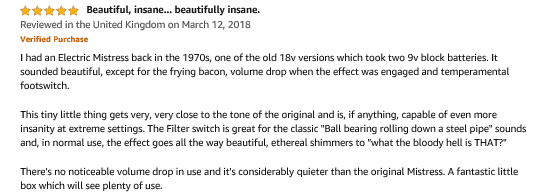Shenzhen Mooer Audio company, with its headquarter in Shenzhen, China is a manufacturer of musical accessories including guitar pedals. The most popular series of guitar effect pedals produced by Mooer is named as the “Micro Series”. Pedals in this series have a similar layout, with a normal sized dial type knob in the center of the pedal controlling the main function. This main knob is surrounded by two to three smaller knobs controlling the supporting functions.
Mooer has been mired in controversy with claims that many of their designs are very similar to popular pedals in the market. Actually in 2019, Electro-Harmonix Pedal Company won a case against Mooer for copyrighted software infringement.
There is a divided opinion on use of such products, with players having budget constraints using them in good numbers. In spite of being very affordable, they offer a decent and sometimes even very impressive level of performance. The product in discussion, Mooer Eleclady Classic Analog Flanger, is also based upon a classic pedal - The Deluxe Electric Mistress, by EHX. This pedal is a tiny version of the original and provides the same feel and sound pretty close.
If you have no issues with trying out the budget alternatives and want to experiment with the features of the legendary pedals without impacting your budget, please read on !!
Things To Consider Before Purchasing A Flanger Pedal
While most experienced or professional players know what they want, it is very common for players just venturing into the world of effects or trying a new effect to get overwhelmed by the sheer number of choices available in the market today. It is recommended to keep the following in mind:
Our Picks for Review
Features and Benefits
Let us look at some of the features and benefits of this classic analog flanger along with the control functions and their effect on the sounds produced by the flanger.
Features
Some of the important features of Mooer E-lady classic analog flanger are:
- 1It is a classic analog flanger with filter mode and oscillator effects.
- 2Mooer Eleclady has two working modes, Normal and the Filter mode. In normal mode, the unit works as a classic analog flanger. While, in the filter mode, the flanging effect gets frozen and the unit creates a static filter sound.
- 3The unit has a full metal shell and its very small and compact design (93.5 x 42 x 52 mm) makes it suitable for any pedal-board. It has a weight of about 160g.
- 4The unit works on a compatible 9V DC power supply (center minus plug) and draws about 10mA current. The small size of the unit makes it unsuitable for batteries.
- 5The input signal to the unit is fed through a 1/4" monaural jack, with the jack impedance of 1 Mega-ohms, while the output also is through a similarly sized monaural jack . The jack impedance for the outside side is 510 ohms.
- 6The unit has a true bypass feature.
Controls
You will be able to utilize any gear fully, if you know about the controls, their function, range and effect on the ultimate sound output. You need to try out different combinations of settings on the knobs to find the settings that work best for you. As highlighted earlier, all devices of Micro series from the manufacturer have a similar layout.
The classic analog flanger is a modulation based effect where rate, depth and shape of the delay acting on the signal is modulated. Let us have a look at available control options on Mooer Elady flanger to carry out the flanging effect.
- 1Mode Switch: This two way toggle switch allows you to transition between the two working modes, Normal and Filter as discussed in the features section.
- 2Rate Control: This controls the speed of the flanger in the normal mode and is disengaged in the filter mode. In any flanger effect, the delay time is continuously changed . Rate defines how fast the delay changes between the limits set by the depth. In full counterclockwise position (CCW), the delay time is swept slowly. It has a very fast and audible rate in full clockwise (CW) position.
- 3Range Control: Range or Depth control determines how much delay is modulated and the shortest and the longest delay times allowed. This is basically the range of the delay time limits. In the filter mode, the knob adjusts the filter matrix.
- 4Color Knob: Color control is also known as the shape control and defines how the delay time oscillates between its limits (perfect sine, square, triangle etc). It adjusts the feedback of the flanger, where some output of delay is fed back to the input, delaying it further and resulting in echo's.
- 5True Bypass Footswitch: It is used to toggle between the ON and bypass status of the Mooer Eleclady analog flanger.
Sound
Sounds of any popular and established pedals like the Deluxe Electric Mistress are not easy to emulate, but Mooer classic analog flanger does a very good job by nearly resembling the sounds of the original, at a much lower price. There are some shortcomings, but not as major, that they cannot be overlooked. It produces classic flanger sound with filter mode and oscillator effects. The video demo below shows the pedal in action, so that you can have a feel of its sonic capabilities.
Some of the highlights of the Eleclady sounds are:
- 1Eleclady has a brighter and metallic sound as compared to the original Mistress.
- 2In the full CW position of the color knob, there may be an oscillator noise tone. While for most time, the color knob is best kept in the middle, you can use the full CW setting to create some unique and crazy spaceship effects. Usually color control will have its sweet spot at around 10.00 setting. Below this setting, the volume may drop significantly.
- 3Eleclady can easily produce the 60's flange sound of Jimi Hendrix on his psychedelic fueled explorations or the Pink Floyd tone of the 70's. Reaching Van Halen's growling jets may be difficult.
- 4It works best with clean or milt boosts, as sounds turn to brittle and harsh with overdrives and distortions.
- 5Rate allows you to speed up the effects and performs best around 3.00 o'clock. Tone is nicely detuned at this setting of the knob.
- 6Filter provides a fixed flange effect like a slight phaser.
Social Proof of the Pedal
We recommend that you satisfy yourself about the quality and performance of the pedal by going through the online reviews, before committing to it. We have put some of the reviews, which are in line with the general opinions of the Mooer e-lady users.

The reviewer has used the original Electric Mistress pedal as well as Mooer e lady pedal. In his opinion the e-lady matches the tone of the original and even performs better at extreme settings. It does not show any drop in volume in use and produces much less noise than the original

This is a detailed review, where the user has covered his views and expressed satisfaction with all the important points and features of the pedal. He recommends it as a budget & compact size flanger.

The reviewer found the product, a convincing replication of the original in terms of tone and at a much lower price. He was able to obtain desired flanging effects without impacting the low end. However, his pedal went dead after 3 months of use resulting in a refund of the amount. We have noticed a couple of reviews with similar issues on the net.
In Conclusion
To conclude, Mooer Eleclady, though a clone of the Electric Mistress, does a very good job in matching the performance of the original at much less price. In fact, in some areas it closely matches or even outperforms the pedal, it has set out to emulate. There are a few downsides also, but overall for the price you pay or if budget is a consideration, it is a great addition to your repertoire of gears. Do check it out below !!




